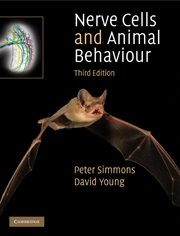Book contents
- Frontmatter
- Contents
- Preface
- 1 Organisation of animal behaviour and of brains: feeding in star-nosed moles and courtship in fruit flies
- 2 Signals in nerve cells: reflexes in mammals and insects
- 3 Neuronal mechanisms for releasing behaviour: predator and prey – toad and cockroach
- 4 Neuronal pathways for behaviour: startle behaviours and giant neurons in crayfish and fish
- 5 Eyes and vision: sensory filtering and course control in insects
- 6 Sensory maps: hunting by owls and bats
- 7 Programmes for movement: how nervous systems generate and control rhythmic movements
- 8 Changes in nerve cells and behaviour: learning in bees and rats; swarming in locusts
- 9 Nerve cells and animal signalling: songs of crickets, electric fish and birds
- References
- Index
- References
5 - Eyes and vision: sensory filtering and course control in insects
Published online by Cambridge University Press: 05 August 2012
- Frontmatter
- Contents
- Preface
- 1 Organisation of animal behaviour and of brains: feeding in star-nosed moles and courtship in fruit flies
- 2 Signals in nerve cells: reflexes in mammals and insects
- 3 Neuronal mechanisms for releasing behaviour: predator and prey – toad and cockroach
- 4 Neuronal pathways for behaviour: startle behaviours and giant neurons in crayfish and fish
- 5 Eyes and vision: sensory filtering and course control in insects
- 6 Sensory maps: hunting by owls and bats
- 7 Programmes for movement: how nervous systems generate and control rhythmic movements
- 8 Changes in nerve cells and behaviour: learning in bees and rats; swarming in locusts
- 9 Nerve cells and animal signalling: songs of crickets, electric fish and birds
- References
- Index
- References
Summary
Diptera (the true, or two-winged, flies) clearly rely on their eyes. They usually escape capture with apparent ease, and during fast flight they turn often, rarely colliding with their surroundings. Good eyesight goes along with aerobatic manoeuvrability: some dipteran behaviours include the most rapid reactions made by animals. An airborne hover fly, blow fly or fruit fly can turn a right angle in less than 50 ms, and can make 10 turns per second (Schilstra and van Hateren,1999; Fry et al., 2003). Flies rarely crash into other objects while airborne, and are able to land precisely on appropriate perches, including cup edges. The spectacle of house flies chasing each other is familiar, and high-speed filming reveals that the chasing fly, usually a male, tracks every turn made by the target fly, often a female but sometimes a rival male (Fig. 5.1a). Robber flies also chase house flies, in this case to prey on them. Although the neuronal pathways involved in visual behaviours of flies and other insects are more complex and involve much larger numbers of neurons than the startle responses of crayfish or fish described in the previous chapter, several visual interneurons of insects have been studied in some detail. Like the T5(2) neurons of toads (Chapter 3), the interneurons respond to particular defined stimulus configurations and so act as feature detectors, and they have been shown to play specific roles in guiding behaviour.
- Type
- Chapter
- Information
- Nerve Cells and Animal Behaviour , pp. 90 - 125Publisher: Cambridge University PressPrint publication year: 2010



